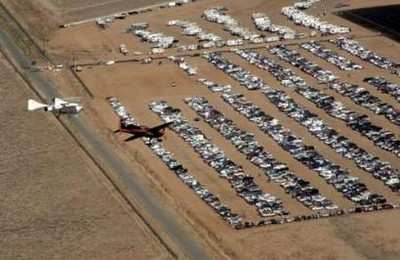Mike Melvill's First Sub-Orbital Flight Made History in
2004
One of the most startling and indelible of our many
aero-memories is five years old today. It involves a point nearly
ten miles high, chasing the first of Burt Rutan's space-proven
rocketships, and the dawning of a new age in which access to space
belongs to everyone.

On June 21st, 2004, Mike Melvill strapped on SpaceShipOne for
the first sub-orbital flight in Burt Rutan's dreamship and went out
and did what so many have tried... and so few have succeeded in
doing... he went to space.

Mike Melvill, then 62, achieved an amazing goal that Monday. He
boosted to an altitude of just slightly over 328,000 feet -- 62.5
miles -- becoming the world's first private-industry astronaut. The
flight was not without some tense moments. Melvill was forced to
resort to some alternate control systems when primary trim systems
failed in flight. ANN Publisher Jim Campbell, flying just feet away
from Scaled's SpaceShipOne in a Beechcraft Starship chase plane
(that followed the combo of WhiteKnight mothership and SpaceShipOne
to the launch poiint and then rejoined upon his return from space),
was the first to report some indications of possible thermal or
load damage on the aft portion of the spacecraft, just in front of
the rocket bell. Worst of all... a momentary communications glitch
at the apex of Mike's flight caused everyone a few nervous moments
until Mike started talking again. Ultimately though, a thorough
check by all three chase planes revealed Melvill's ship was sound
for landing. He made a perfect touchdown at the airport in Mojave
(CA) at 1114 EDT.

ANN had an amazing vantage point for all this... this was the
first of a number of flights where ANN's Jim Campbell served as the
sole or primary photographer for a number of historic XPrize
moments and was aboard the chase ship that shepherded Melvill
nearly all the way to his drop point and gave him the once-over
just minutes before landing. Jim was aboard the Starship, shooting
some of the 400 high-resolution digital images that he captured
that day. It was an amazing flight... a dramatic flight... but he
also observed and photographed history from about as close as you
could possibly get to the world's newest spaceship and astronaut.
Our pictures were seen around the world, graced hundreds of
newspaper and other periodical covers, since we shot the only
air-to-air pool photos of the flight -- though we are pleased to
note that these photos (shown above and below) appeared FIRST on
ANN.

The visions are indelible, even five years later... but more
important than the sights we witnessed that day are the many
changes that are in the offing due to the genius and committment of
Rutan and his extraordinary team, Melvill's skill, and XPrize
Founder Peter Diamandis's uncommon vision of a space future that
could belong to anyone.

Here's Scaled's Mission Summary for Mike and Burt's Grand
Adventure:
Flight 60L / 15P
Date: 21 June 04
Flight Time: 1.6 hour / 24 min 05sec
White Knight Pilot: Binnie White Knight Copilot: Stinemetze
SpaceShipOne Pilot: Melvill
High Chase Alpha Jet Crew: Van der Schueren/Johnson
High Chase-Starship Crew:
Karkow/Scherer
Low Chase-Extra Crew: Coleman/Bird

Objectives: First commercial astronaut flight
by exceeding 100 kilometers (328,000 ft)

Results: Cheered down the runway by onlookers,
the White Knight turbojet launch aircraft took off at 647 a.m. PST,
carrying SpaceShipOne under its fuselage to an altitude of 47,000
feet. At 750 a.m. PST, flight engineer Matt Stinemetz released the
spaceship and test pilot Mike Melville immediately fired the hybrid
rocket motor. The rocket burn lasted for 76 seconds rocketing the
vehicle to more than 2.9 Mach or 2150 miles an hour. At motor burn
out, SpaceShipOne was at 180,000 feet and from there coasted the
rest of the way into space reaching an apogee of 328,491 feet.
Melvill experienced weightlessness for approximately 3 minutes
as the vehicle slowly decelerated to apogee and then yielding to
the pull of gravity commenced its historic return to earth in the
craft's unique entry or feathered configuration. During the descent
the pilot experienced forces greater than 5.0 G's as the vehicle
accelerated again to 2.9 Mach. Melvill reconfigured the vehicle
back to a glider at 57,000 feet and over the next 20 minutes
enjoyed a leisurely descent to a graceful landing at Mojave, the
Nation's first inland Space Port.

SpaceShipOne Flight 15P Anomaly: As mentioned
in the post-flight press conference, during SpaceShipOne's historic
flight to 100 kilometers on 21 June 2004 there was a flight control
malfunction. Late in the boost phase, the vehicle s primary pitch
trim control was lost. Scaled views any flight control system
anomaly as a serious matter, but to guard against these problems,
the vehicle has redundancy on all flight-critical systems,
including pitch trim. So when the failure occurred, test pilot Mike
Melvill switched to the backup system and continued the planned
mission. However, the resulting trajectory excursion had two
effects. One, the vehicle didn't climb as high as planned and two,
the space ship re-entered south of the intended recovery point.
This latter effect, while undesirable, was well within the
vehicle's glide capability and SpaceShipOne had no difficulty
flying back to Mojave Space Port for a normal landing.

 NTSB Final Report: Patriot Aircraft LLC CX1900A
NTSB Final Report: Patriot Aircraft LLC CX1900A Aero-News: Quote of the Day (12.06.25)
Aero-News: Quote of the Day (12.06.25) ANN's Daily Aero-Term (12.06.25): High Speed Taxiway
ANN's Daily Aero-Term (12.06.25): High Speed Taxiway ANN's Daily Aero-Linx (12.06.25)
ANN's Daily Aero-Linx (12.06.25) Airborne-NextGen 12.02.25: Honda eVTOL, Arctus High-Alt UAS, Samson Patent
Airborne-NextGen 12.02.25: Honda eVTOL, Arctus High-Alt UAS, Samson Patent










